Modeling Habitat Suitability of Snow Leopards in Yanchiwan National Reserve, China
Abstract
:Simple Summary
Abstract
1. Introduction
2. Materials and Methods
2.1. Study Area
2.2. Snow Leopard Species Distribution Data Collection
2.3. Spatial Distribution Analysis for Snow Leopard Habitat Suitability
2.4. Cluster Analysis for Snow Leopard Habitat Suitability
2.5. Temporal Trends in Habitat Suitability for Snow Leopards
2.6. Collection of Scat Samples of Snow Leopards
Camera Trap Data Collection
2.7. Collection and Screening of Environmental Data
2.8. Maximum Entropy Model Parameter Settings
3. Results
3.1. Habitat Suitability Distribution of Snow Leopards
3.2. Environmental Drivers of Suitability Distribution of Snow Leopards
3.3. Spatial Distribution Analysis for Snow Leopard Habitat Suitability
3.4. Cluster Analysis for Snow Leopard Habitat Suitability
3.5. Temporal Trends in Habitat Suitability for Snow Leopards
4. Discussion
4.1. Impact of Environmental Factors on Snow Leopard Habitat
4.2. Limitations of the Study
5. Recommendations
6. Conclusions
Author Contributions
Funding
Institutional Review Board Statement
Informed Consent Statement
Data Availability Statement
Acknowledgments
Conflicts of Interest
References
- Jackson, R.M.; Roe, J.D.; Wangchuk, R.; Hunter, D.O. Surveying Snow Leopard Populations with Emphasis on Camera Trapping: A Handbook; Snow Leopard Conservancy: Sonoma, CA, USA, 2005; p. 73. [Google Scholar]
- Fox, J.L. Snow leopard conservation in the wild—A comprehensive perspective on a low density and highly fragmented population. In Proceedings of the 7th International Snow Leopard Symposium, Xining, China, 25–30 July 1992. [Google Scholar]
- Jiang, Z. Snow leopard. J. Zool. 1994, 41, 128. [Google Scholar]
- Wen, P.; Chen, X.; Wei, Y.; Yang, Z.; Dai, Q. Habitat suitability evaluation of ungulate protected animals in Baishuihe National Reserve based on MaxEnt model. Sichuan For. Sci. Technol. 2021, 42, 70–75. [Google Scholar]
- Qiao, M.; Shi, X.; Cheng, Y.; Hu, Q.; Li, W.; Zhang, H. Prediction of suitable habitat for snow leopard (Panthera uncia) in Wolong National Nature Reserve based on MaxEnt model. Sichuan For. Sci. Technol. 2017, 38, 1–4+16. [Google Scholar]
- Chi, X.; Gao, H.; Qin, W.; Wu, T.; Zhang, J.; Cai, Z.; Zhang, T. Habitat suitability analysis of snow leopard and blue sheep in Sanjiangyuan National Park. Acta Anim. Sci. 2019, 39, 397–409. [Google Scholar]
- Schaller, G.B.; Qiu, M. Status of the snow leopard Panthera uncia in Qinghai and Gansu Provinces, China. Biol. Conserv. 1988, 45, 179–194. [Google Scholar] [CrossRef]
- Zhang, C.; Alexander, J.S.; Dou, Z.; Wu, L.; Dong, W.; Dabuxilite, J.S.; Yang, J.; Shi, K. Biodiversity assessment of mammal and bird species from camera trap data in Yanchiwan National Nature Reserve, Gansu Province, China. J. Resour. Ecol. 2018, 9, 566–574. [Google Scholar]
- Namgung, H.; Kim, M.-J.; Baek, S.; Lee, J.-H.; Kim, H. Predicting potential current distribution of Lycorma delicatula (Hemiptera: Fulgoridae) using MaxEnt model in South Korea. J. Asia-Pac. Entomol. 2020, 23, 291–297. [Google Scholar] [CrossRef]
- Guga, S.; Xu, J.; Riao, D.; Li, K.; Han, A.; Zhang, J. Combining MaxEnt model and landscape pattern theory for analyzing interdecadal variation of sugarcane climate suitability in Guangxi, China. Ecol. Indic. 2021, 131, 108152. [Google Scholar] [CrossRef]
- Elith, J.; Hastie, T.; Dudík, M.; Chee, Y.E.; Yates, C. A statistical explanation of MAXENT for ecologists. Divers. Distrib. 2010, 17, 43–57. [Google Scholar] [CrossRef]
- Phillips, S.J.; Dudík, M. Modeling of species distributions with MaxEnt: New extensions and a comprehensive evaluation. Ecography 2008, 31, 161–175. [Google Scholar] [CrossRef]
- Smith, A.C.; Parfitt, D.; Robertson, A.; Kinney, K.; Rybin, A.; Markelov, M.; Miquelle, D. Predicting the potential distribution of Amur tiger (Panthera tigris altaica) in the Russian Far East using MaxEnt modeling. Glob. Ecol. Conserv. 2019, 18, e00613. [Google Scholar]
- Li, X.; Wu, Z.; Zhang, L. Snow leopard distribution in China. J. Wildl. Manag. 2018, 82, 421–429. [Google Scholar]
- Zhang, T.; Li, S.; Wang, Y. Snow leopard sightings in Yanchiwan National Nature Reserve. Chin. J. Wildl. 2019, 30, 288–296. [Google Scholar]
- Wilson, D.E.; Reeder, D.M.; Mittermeier, R.A. Habitat fragmentation and its impact on mammal species. Conserv. Biol. 2020, 25, 56–64. [Google Scholar]
- Elith, J.; Kearney, M.; Phillips, S.J. The role of ecological niche models in conservation. Annu. Rev. Ecol. Evol. Syst. 2011, 42, 347–368. [Google Scholar]
- Zhao, H.; Zhang, D.Z. Ecological problems and research countermeasures in Yanchiwan National Nature Reserve. Gansu For. Sci. Technol. 2009, 34, 53–56. [Google Scholar]
- Zhang, Q.; Li, Y.; Yang, Q.; Zhang, Z. Evaluation of ecological protection status of national nature reserves. Environ. Dev. 2019, 31, 14–15. [Google Scholar]
- Yang, J.; Se, Y.; Ma, Z. Analysis on the evolution of landscape pattern in Yanchiwan National Nature Reserve. Environ. Sci. Technol. 2020, 43, 185–191. [Google Scholar]
- Wang, J. A Multiscale Assessment of Snow Leopard Distribution, Habitat-Use, and Landscape Connectivity in a New National Park in China. Ph.D. Thesis, Manchester Metropolitan University, Manchester, UK, 2022. [Google Scholar]
- Sharma, K.; Bayrakcismith, R.; Tumursukh, L.; Johansson, O.; Sevger, P.; McCarthy, T. Vigorous dynamics underlie a stable population of the endangered snow leopard Panthera uncia in Tost Mountains, South Gobi, Mongolia. PLoS ONE 2014, 9, e101319. [Google Scholar] [CrossRef]
- Fick, S.E.; Hijmans, R.J. WorldClim 2: New 1-km spatial resolution climate surfaces for global land areas. Int. J. Climatol. 2017, 37, 4302–4315. [Google Scholar] [CrossRef]
- Venne, S.; Currie, D.J. Can habitat suitability estimated from MaxEnt predict colonizations and extinctions? Divers. Distrib. 2021, 27, 873–886. [Google Scholar] [CrossRef]
- Phillips, S.J.; Anderson, R.P.; Schapire, R.E. Maximum entropy modeling of species geographic distributions. Ecol. Model. 2006, 190, 231–259. [Google Scholar] [CrossRef]
- Bai, D.-F.; Chen, P.-J.; Atzeni, L.; Cering, L.; Li, Q.; Shi, K. Assessment of habitat suitability of the snow leopard (Panthera uncia) in Qomolangma National Nature Reserve based on MaxEnt modeling. Zool. Res. 2018, 39, 373. [Google Scholar] [PubMed]
- Xu, F.; Yin, S.; Bariushaa, M. Autumn habitat selection for snow leopards in Beita Mountain, Xinjiang. Zool. Res. 2006, 27, 221–224. [Google Scholar]
- Elith, J.; Leathwick, J.R. Species Distribution Models: Ecological Explanation and Prediction Across Space and Time. Annu. Rev. Ecol. Evol. Syst. 2009, 40, 677–697. [Google Scholar] [CrossRef]
- Freeman, E.A.; Moisen, G.G. A comparison of the performance of threshold criteria for binary classification in terms of predicted prevalence and kappa. Ecol. Model. 2008, 217, 48–58. [Google Scholar] [CrossRef]
- Hernandez, P.A.; Graham, C.H.; Master, L.L.; Albert, D.L. The effect of sample size and species characteristics on performance of different species distribution modeling methods. Ecography 2006, 29, 773–785. [Google Scholar] [CrossRef]
- Merow, C.; Smith, M.J.; Silander, J.A. A practical guide to MaxEnt for modeling species’ distributions: What it does, and why inputs and settings matter. Ecography 2013, 36, 1058–1069. [Google Scholar] [CrossRef]
- Phillips, S.J.; Anderson, R.P.; Dudík, M.; Schapire, R.E.; Blair, M.E. Opening the black box: An open-source release of Maxent. Ecography 2017, 40, 887–893. [Google Scholar] [CrossRef]
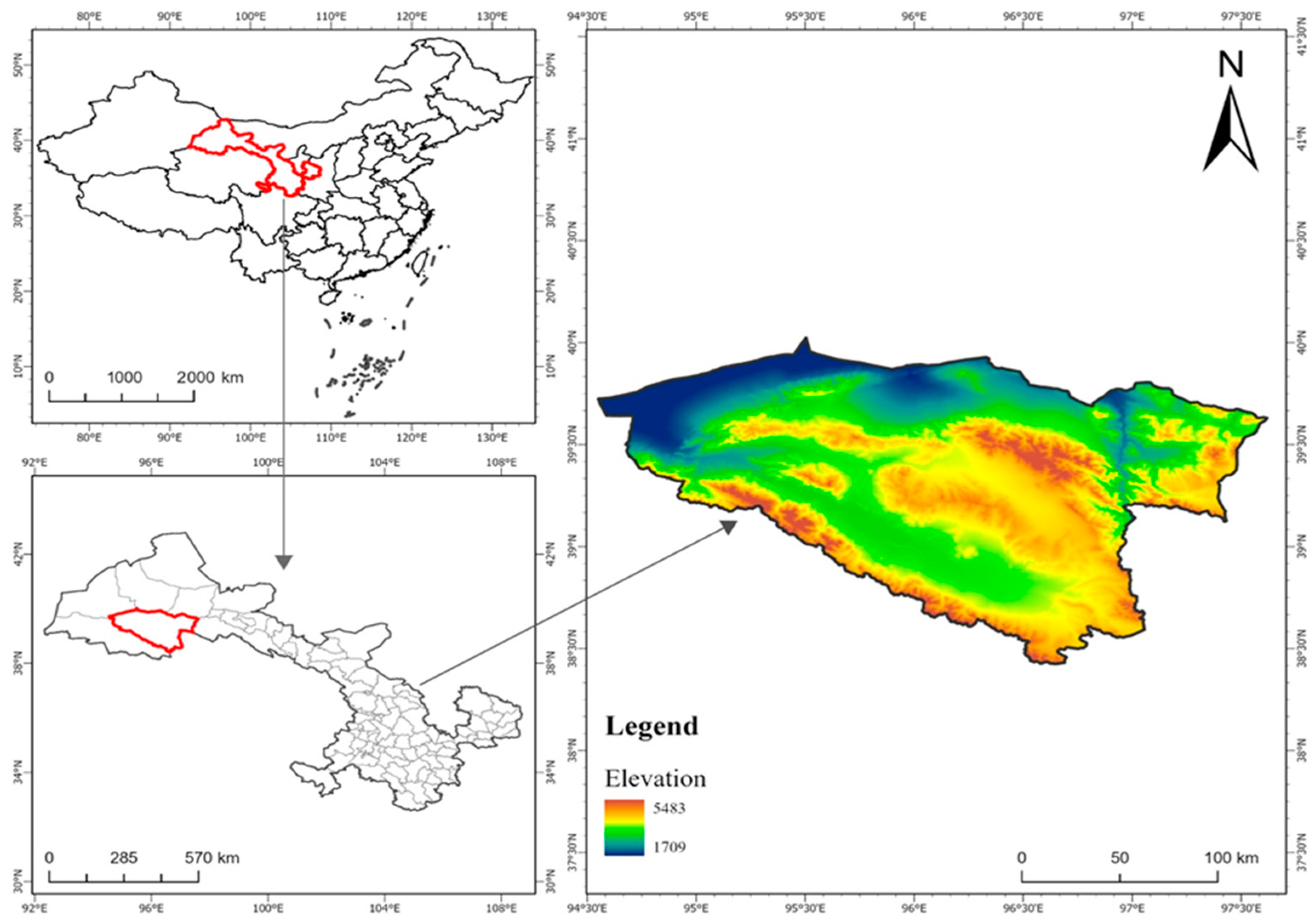
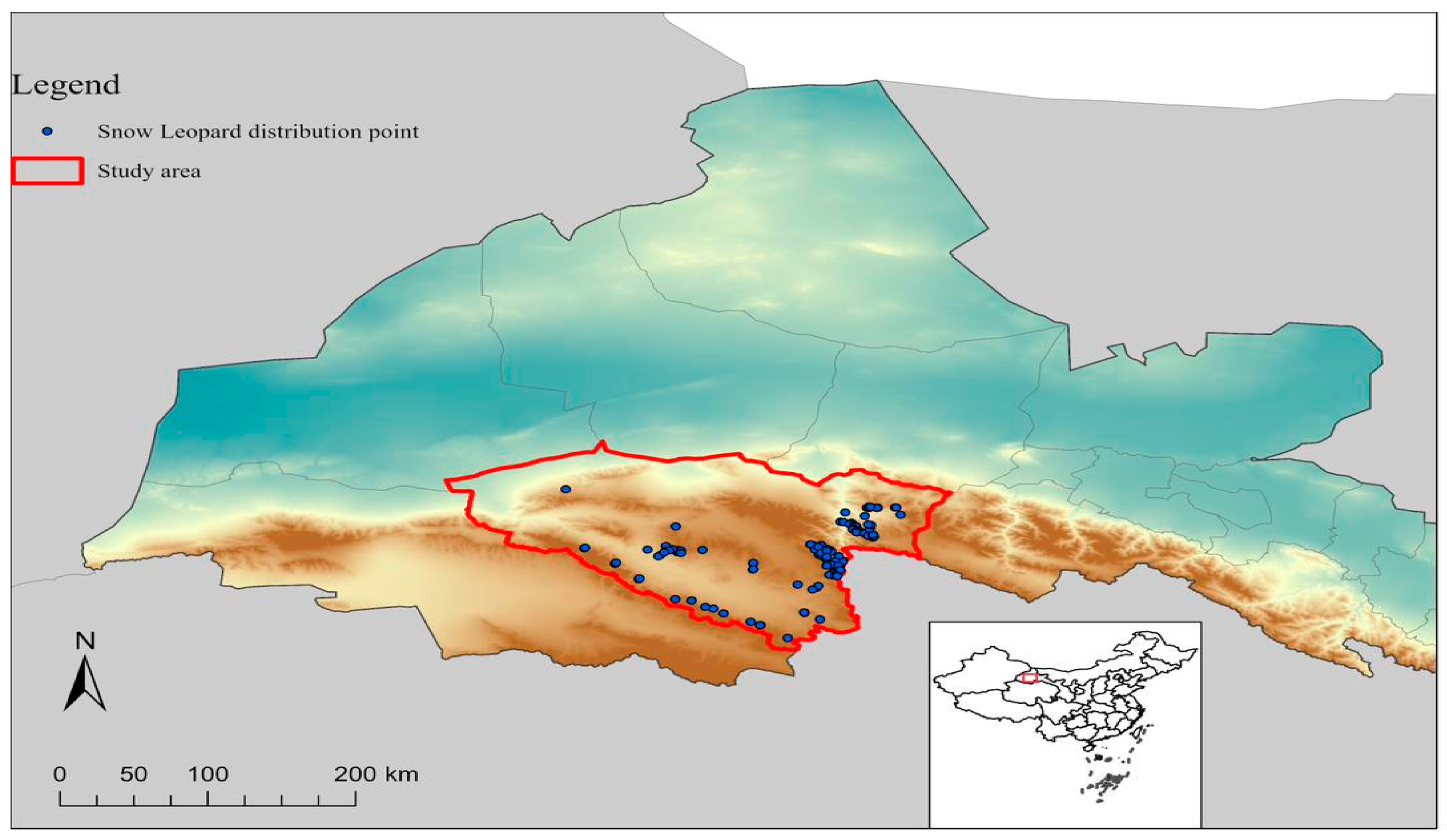

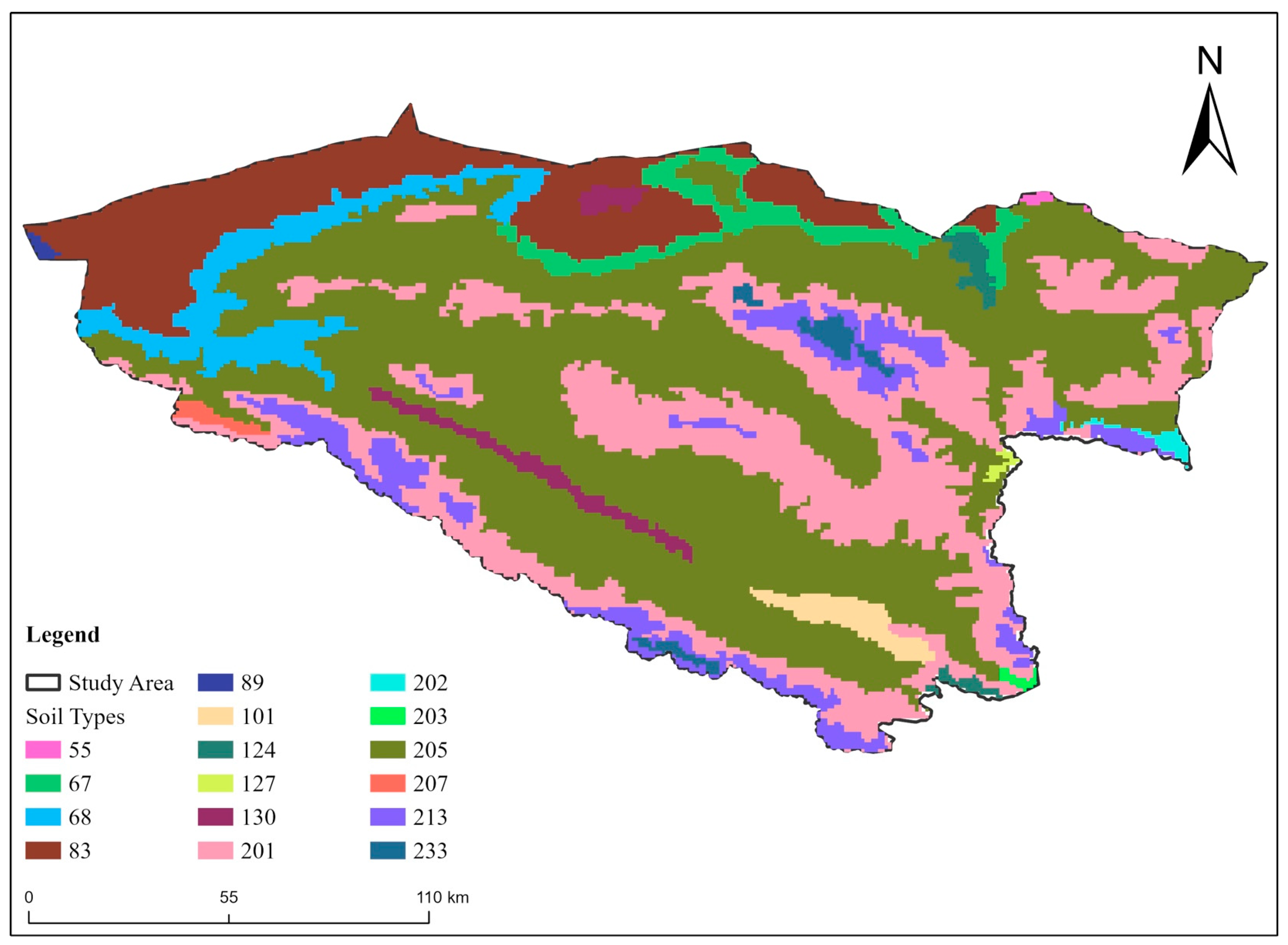
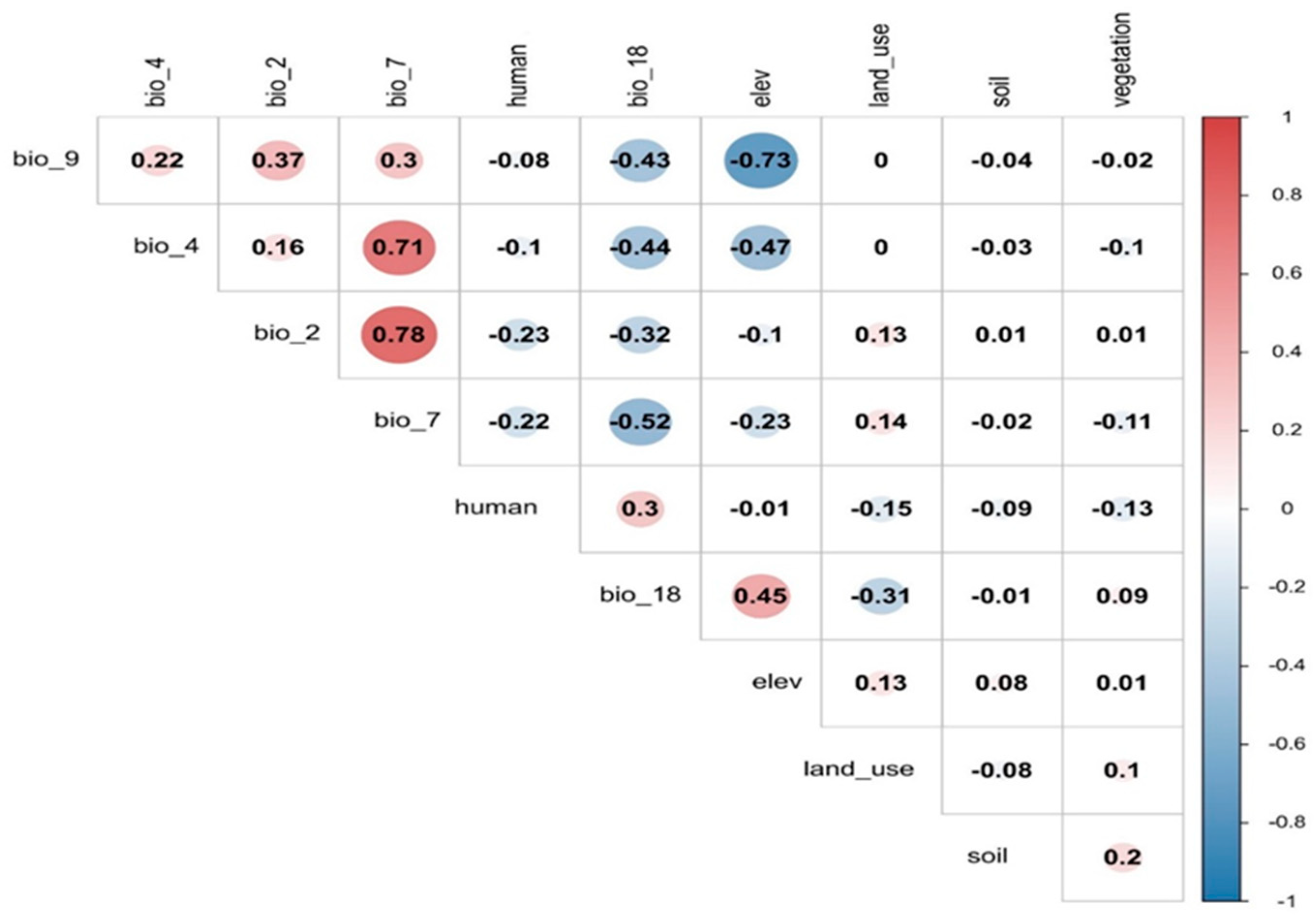
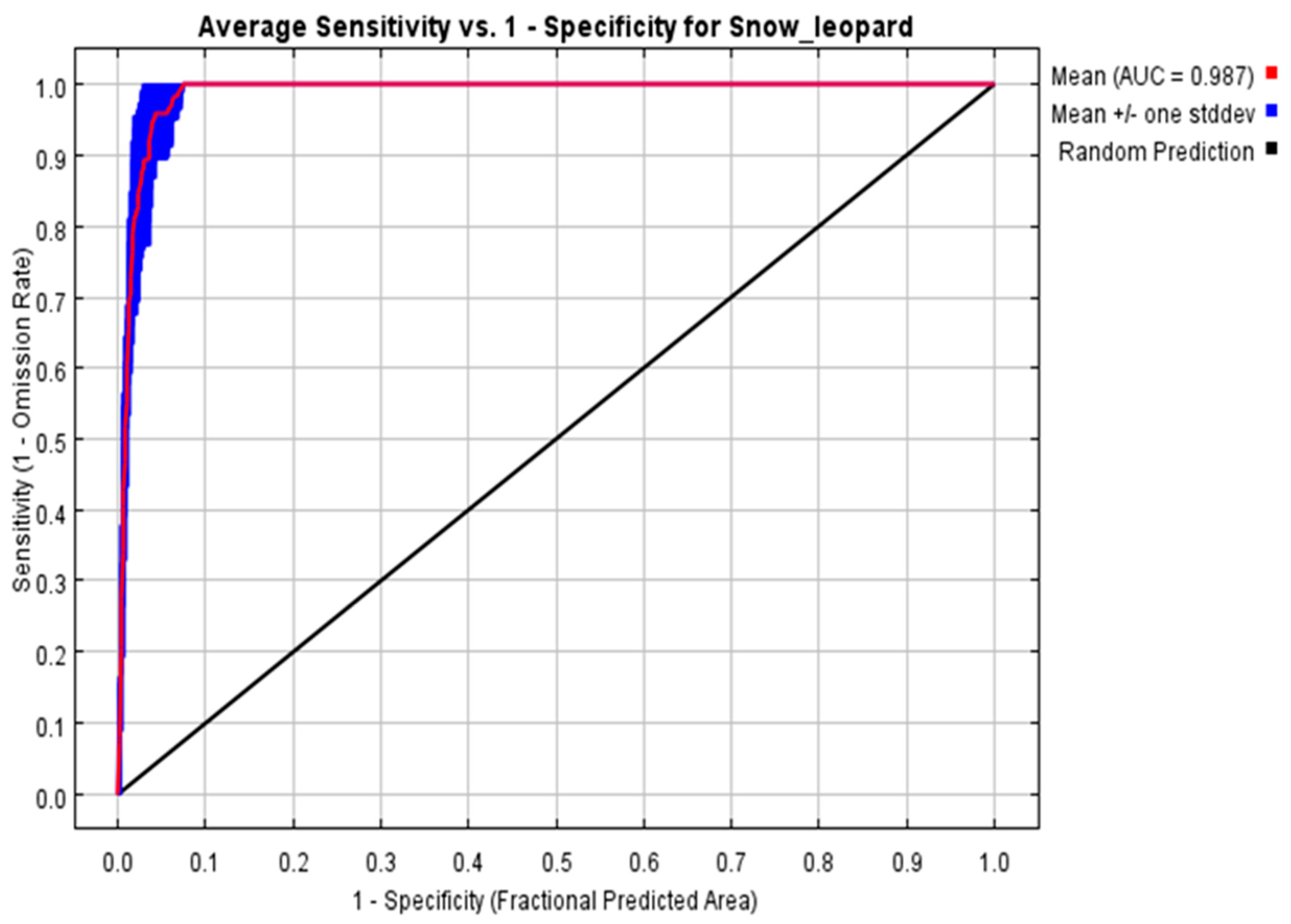

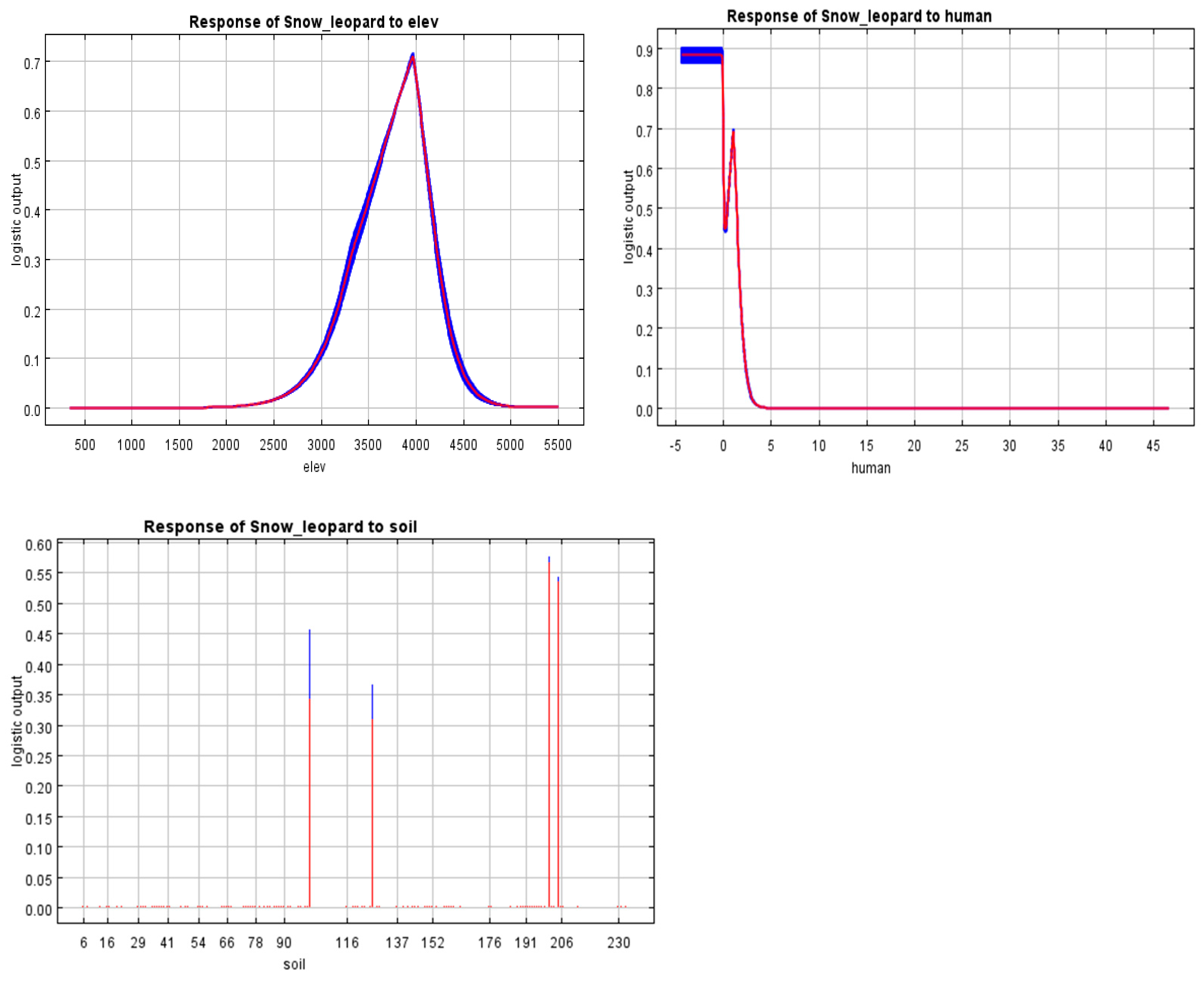
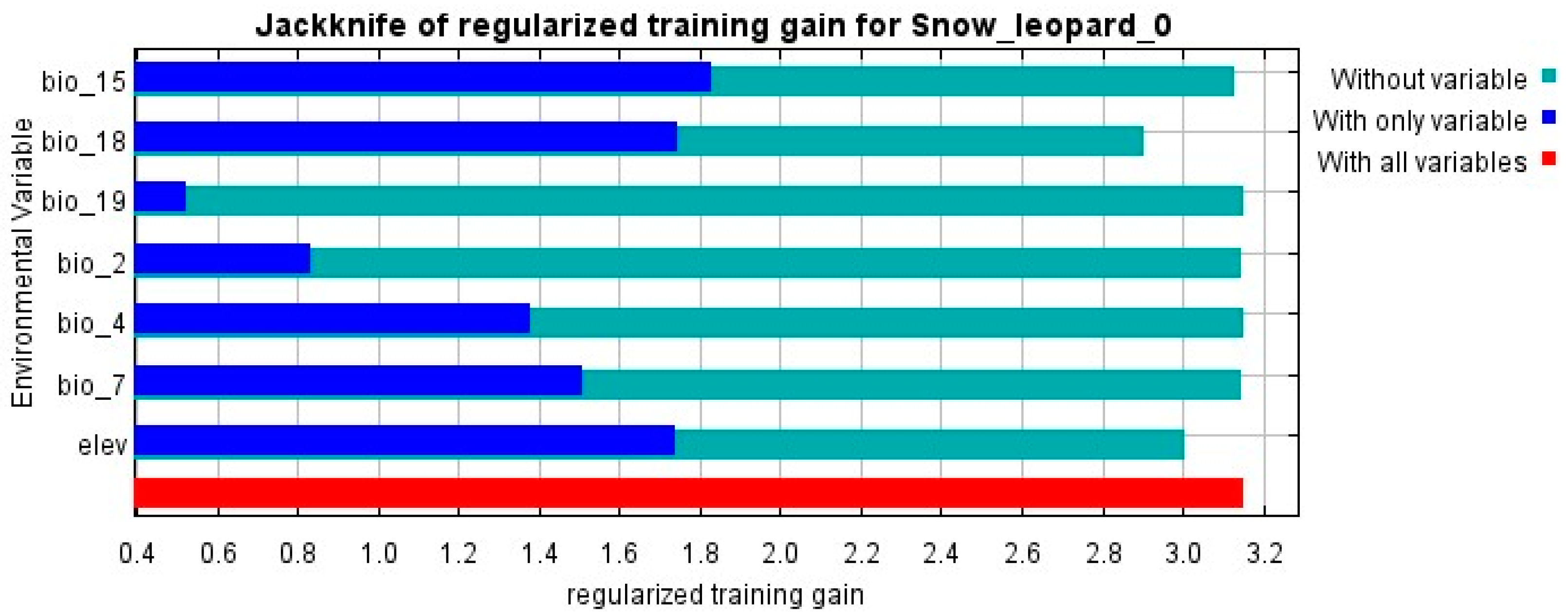
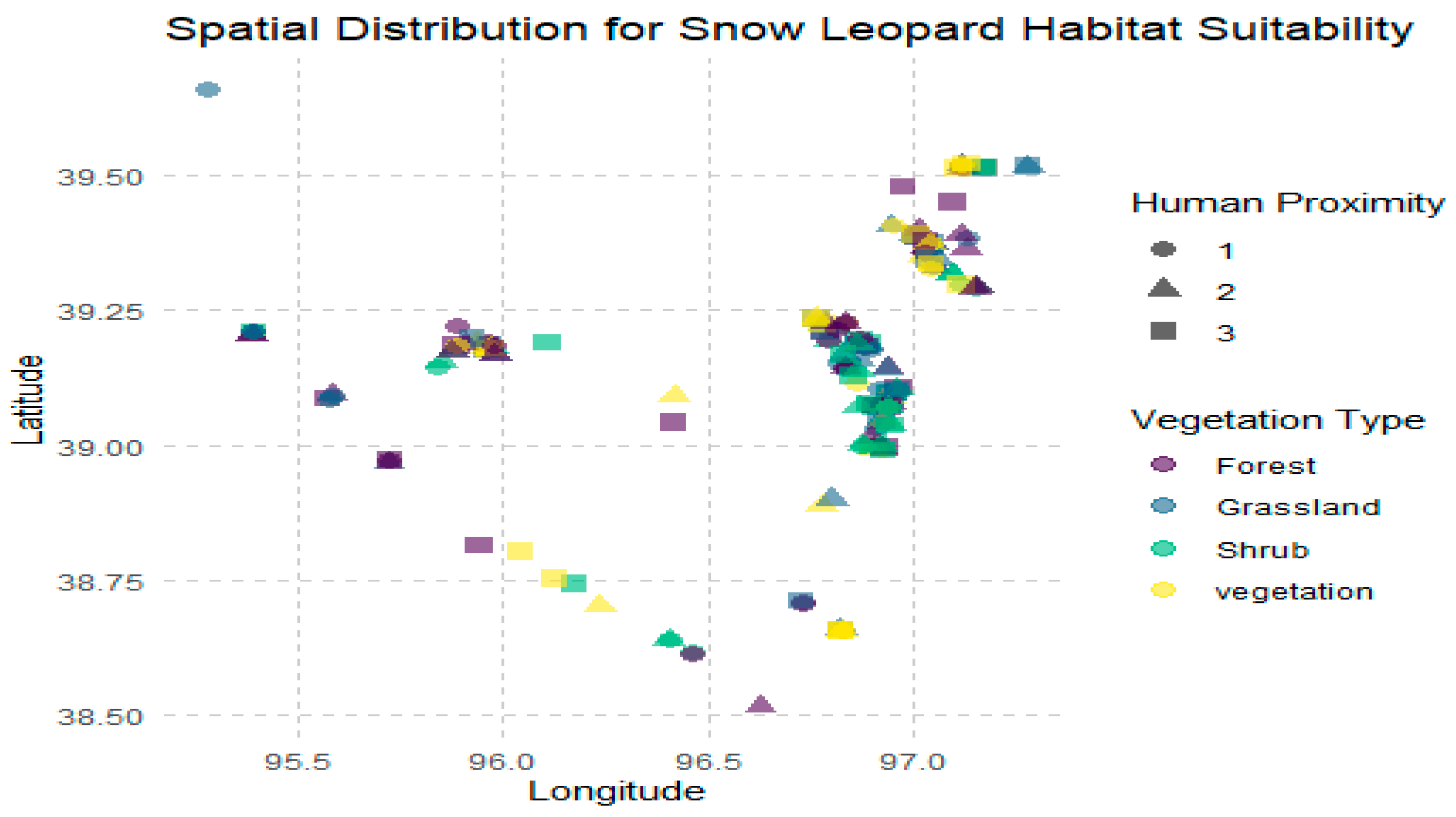

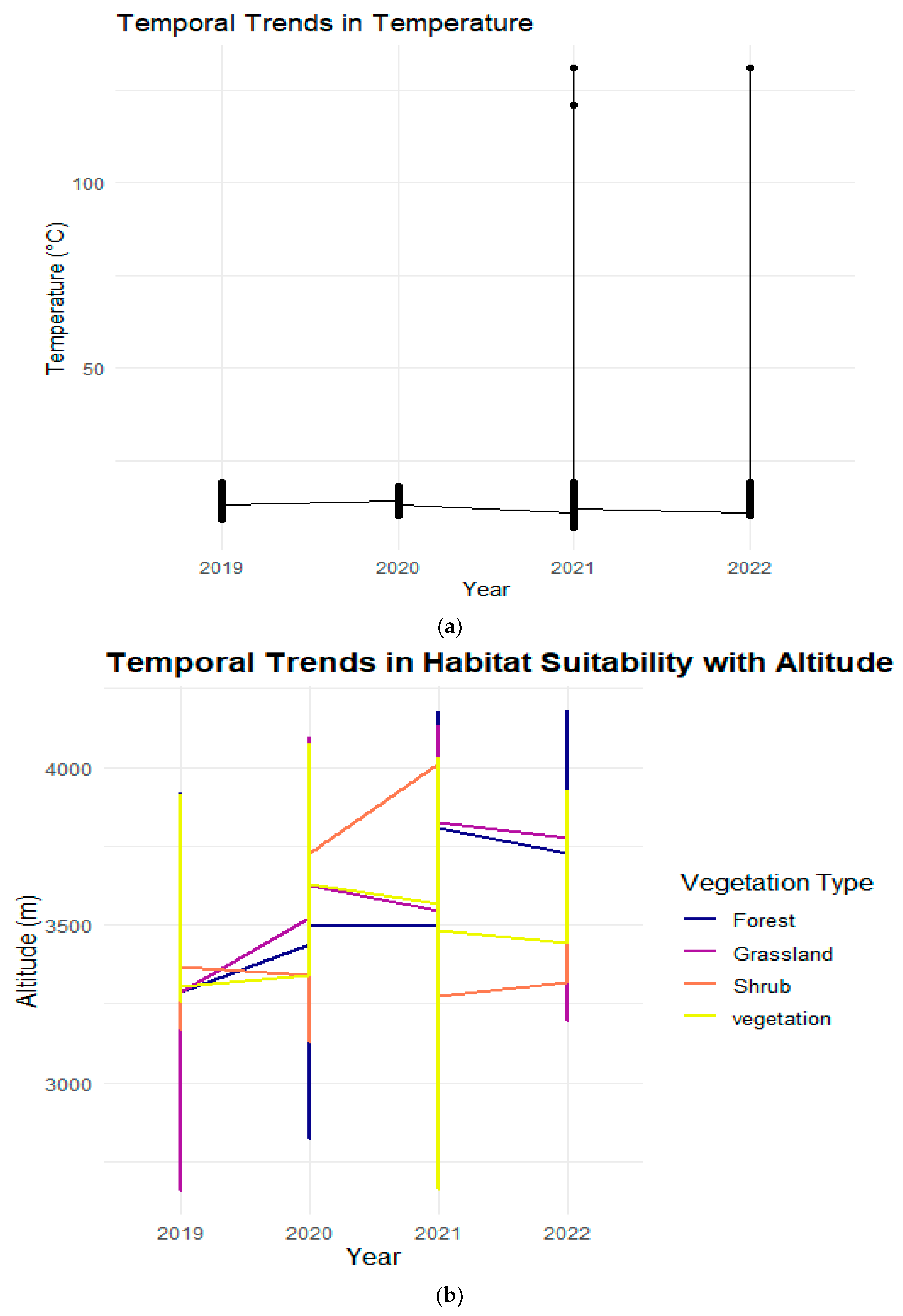

| No. | Soil Types Code | Soil Types | Percentage |
|---|---|---|---|
| 1 | 55 | Chestnut Calcic Soil | 0.08% |
| 2 | 67 | Brown Calcic Soil | 2.98% |
| 3 | 68 | Light Brown Calcic Soil | 4.36% |
| 4 | 83 | Grey Brown Desert Soil | 11.84% |
| 5 | 89 | Gypsum Brown Desert Soil | 0.10% |
| 6 | 101 | Steppe Wind Sandy Soil | 1.09% |
| 7 | 124 | Calcareous Coarse Skeletal Soil | 0.66% |
| 8 | 127 | Calcareous Meadow Soil | 0.10% |
| 9 | 130 | Salinized Meadow Soil | 1.43% |
| 10 | 201 | Cold Calcic Soil | 22.39% |
| 11 | 202 | Dark Cold Calcic Soil | 0.24% |
| 12 | 203 | Light Cold Calcic Soil | 0.10% |
| 13 | 205 | Cold Calcic Soil | 48.24% |
| 14 | 207 | Light Cold Calcic Soil | 0.29% |
| 15 | 213 | Frozen Soil | 5.33% |
| 16 | 233 | Glacial Snow Cover | 0.77% |
| Abbreviations | Environmental Factor |
|---|---|
| BIO1 | Annual Mean Temperature |
| BIO2 | Mean Diurnal Range (mean of monthly (max temp − min temp)) |
| BIO3 | Isothermality (BIO2/BIO7) (×100) |
| BIO4 | Temperature Seasonality (standard deviation × 100) |
| BIO5 | Max Temperature of Warmest Month |
| BIO6 | Min Temperature of Coldest Month |
| BIO7 | Temperature Annual Range (BIO5 − BIO6) |
| BIO8 | Mean Temperature of Wettest Quarter |
| BIO9 | Mean Temperature of Driest Quarter |
| BIO10 | Mean Temperature of Warmest Quarter |
| BIO11 | Mean Temperature of Coldest Quarter |
| BIO12 | Annual Precipitation |
| BIO13 | Precipitation of Wettest Month |
| BIO14 | Precipitation of Driest Month |
| BIO15 | Precipitation Seasonality (coefficient of variation) |
| BIO16 | Precipitation of Wettest Quarter |
| BIO17 | Precipitation of Driest Quarter |
| BIO18 | Precipitation of Warmest Quarter |
| BIO19 | Precipitation of Coldest Quarter |
| Elev | Elevation |
| Soil | Soil type |
| Vegetation | Vegetation type |
| Human | Human footprint |
| Land_use | Land Use |
| No. | Vegetable Types Code | Vegetable Types | Percentage |
|---|---|---|---|
| 1 | 246 | Subalpine Deciduous Broadleaf Shrubland | 0.14% |
| 2 | 277 | Temperate Shrub Desert | 0.94% |
| 3 | 302 | Temperate Semi-shrubs and Dwarf Semi-shrubs Desert | 14.25% |
| 4 | 341 | Temperate Succulent Halophytic Dwarf Semi-shrubs Desert | 1.08% |
| 5 | 369 | Temperate Tufted Grass Typical Steppe | 30.52% |
| 6 | 394 | Temperate Tufted Dwarf Grass and Dwarf Semi-shrubs Desert Steppe | 16.53% |
| 7 | 4151 | Alpine Grass and Sedge Steppe | 12.95% |
| 8 | 483 | Temperate Grass and Miscellaneous Grass Halophytic Meadow | 1.41% |
| 9 | 498 | Alpine Kobresia Grass and Miscellaneous Grass Meadow | 7.65% |
| 10 | 553 | Alpine Cushion Vegetation | 5.34% |
| 11 | 556 | Alpine Sparse Vegetation | 6.76% |
| 12 | 9904 | Others | 2.43% |
| Variable | Percent Contribution (%) |
|---|---|
| Elev | 29.2 |
| Human | 24.6 |
| Soil | 23.9 |
| Bio_18 | 5.7 |
| Bio_15 | 4.0 |
| Bio_9 | 3.7 |
| Vegetation | 3.2 |
| Bio_7 | 2.6 |
| Bio_2 | 1.9 |
| Land_use | 0.7 |
| Bio_4 | 0.5 |
Disclaimer/Publisher’s Note: The statements, opinions and data contained in all publications are solely those of the individual author(s) and contributor(s) and not of MDPI and/or the editor(s). MDPI and/or the editor(s) disclaim responsibility for any injury to people or property resulting from any ideas, methods, instructions or products referred to in the content. |
© 2024 by the authors. Licensee MDPI, Basel, Switzerland. This article is an open access article distributed under the terms and conditions of the Creative Commons Attribution (CC BY) license (https://creativecommons.org/licenses/by/4.0/).
Share and Cite
Ismaili, R.R.R.; Peng, X.; Li, Y.; Ali, A.; Ahmad, T.; Rahman, A.U.; Ahmad, S.; Shi, K. Modeling Habitat Suitability of Snow Leopards in Yanchiwan National Reserve, China. Animals 2024, 14, 1938. https://doi.org/10.3390/ani14131938
Ismaili RRR, Peng X, Li Y, Ali A, Ahmad T, Rahman AU, Ahmad S, Shi K. Modeling Habitat Suitability of Snow Leopards in Yanchiwan National Reserve, China. Animals. 2024; 14(13):1938. https://doi.org/10.3390/ani14131938
Chicago/Turabian StyleIsmaili, Rashid Rasool Rabbani, Xiaoxu Peng, Yibin Li, Arshad Ali, Tariq Ahmad, Anees Ur Rahman, Shahid Ahmad, and Kun Shi. 2024. "Modeling Habitat Suitability of Snow Leopards in Yanchiwan National Reserve, China" Animals 14, no. 13: 1938. https://doi.org/10.3390/ani14131938






